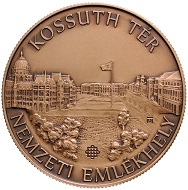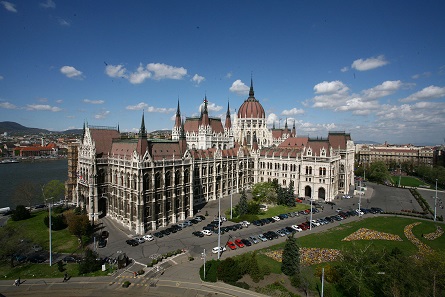December 14, 2017 – The Magyar Nemzeti Bank is issuing a 2,000-forint non-ferrous collector coin, with a profile view of one of the sculpted lions “guarding” the main entrance to the Parliament as the main motif of the obverse and the national flag in the background. The collector coin was launched at the initiative of the National Heritage Institute in 2014 and enriches the series of coins presenting national memorials in Hungary, as the fourth member of the series after the coins on Somogyvár-Kupavár, Mohács and the New Public Cemetery in Rákoskeresztúr.
Hungary / HUF 2.000 / Copper-Nickel / 18.4g / 37mm / Mintage: 5,000.
The reverse shows a perspective view of Kossuth Square, with the iconic buildings of this special national memorial site. The logo of the national memorial can be seen above the legend at the bottom, in the middle, while the mark of the coin’s designer Zoltán Tóth can be discerned hidden in the central motif.
Hungarian Parliament Building, Kossuth Square. Photo: Szász Pál / Wikimedia Commons / CC BY-SA 3.0.
Kossuth Square in Budapest is a key location in Hungarian history, which the National Assembly declared the only special-status national memorial, effective from 1 January 2012. The massive Parliament building, which houses Hungary’s legislature, dominates the Square, where most national memorial services and celebrations are held. Large political rallies and demonstrations are frequently held there, as Kossuth Square now symbolises Hungarian statehood in Hungarian cultural and political discourse, due to its significance in the legislative process. Even though the former Tömö Square was also a public square, the current Kossuth Square clearly came into existence with the construction of the Parliament building.
Following the Compromise of 1867, Hungary’s political leaders were intent on providing a prominent building to house the legislature and reflect Budapest’s growing importance as a major metropolitan centre. At that time, the house of representatives met in Föherceg Sándor Street (today: Bródy Sándor Street), while the house of lords met in the grand hall of the National Museum. A bill on the construction of the Parliament was passed in 1880. The government not only envisioned the building as the seat of parliament: it was to represent the 1000-year history of Hungarian statehood and serve as a reminder of the “ancient constitution”. With this in mind, they required that the building be planned in historicist style. The architectural plans of Imre Steindl featured neo-gothic elements reminiscent of the English Houses of Parliament. In addition to the aesthetic virtues, the design also met with the decision-makers’ approval as the Hungarian politicians of that age frequently compared the Hungarian parliamentary system and constitution with the English system. After some modifications, the National Assembly approved the final plans in 1888.
The Square was renamed Parliament Square in 1898, while the building itself was completed in 1904, even though the representatives had already moved in two years earlier. The architect Steindl, who also oversaw construction, did not live to see completion of his great work as he died in 1902. Situated on the banks of the Danube, the iconic Parliament has become a defining element of Budapest’s urban landscape.
For more information on this release visit the website of the Magyar Nemzeti Bank.
The latest addition to the Hungarian national memorial coin series can be purchased through the webshop of the Hungarian Mint Ltd.
To experience an impressive sightseeing flight above Budapest’s Kossuth Square, watch this film on YouTube.







